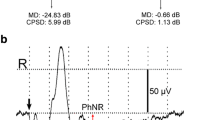Summary
Perimetry at various times of day in patients with large visual field defects due to postretinal lesions showed significant variations of visual field size. The largest visual fields were observed at noon, the smallest in the evening. Such systematic variations were observed only in patients who showed a gradual increase of increment threshold between the intact parts of the visual field and the scotoma. In two patients who showed an abrupt transition between intact and blind areas of the visual field, no obvious diurnal variation was observed. It is suggested that an endogenous modulation of neuronal sensitivity coupled to a hypothetical circadian oscillator is the basis of the diurnal variation.
Similar content being viewed by others
References
Aschoff, J.: Circadian rhythms in man. Science 148, 1427–1432 (1965)
Aschoff, J., Pohl, H.: Rhythmic variations in energy metabolism. Fed. Proc. 29/A, 1541–1552 (1970)
Aulhorn, E., Harms, H.: Visual perimetry. In: Handbook of Sensory Physiology, Vol. VII/4, Visual Psychophysics (eds. D. Jameson, L.M. Hurvich), pp. 102. Berlin-Heidelberg-New York: Springer 1972
Hockey, G.R.J., Colquhoun, W.P.: Diurnal variation in human performance: A review. In: Aspects of human efficiency: Diurnal rhythms and loss of sleep (ed. W.P. Colquhoun). London: The English Universities Press 1972
Klein, K.E., Wegmann, H.M., Brüner, H.: Circadian rhythm in indices of human performance, physical fitness and stress resistance. Aerospace Med. 39/5, 512–518 (1968)
Pöppel, E.: Tagesperiodische Veränderungen der akustischen Adaptation und des psychomotorischen Tempos mit und ohne Nachtruhe. Pflügers Arch. ges. Physiol. 300, 11 (1968)
Pöppel, E., Giedke, H.: Diurnal variation of time perception. Psychol. Forsch. 34, 182–198 (1970)
Pöppel, E., Held, R., Frost, D.: Residual visual function after brain wounds involving the central visual pathways in man. Nature (Lond.) 243, 295–296 (1973)
Saint Paul, U. von, Aschoff, J.: Gehirntemperatur bei Hühnern. Pflügers Arch. ges. Physiol. 301, 109–123 (1968)
Siegel, S.: Nonparametric statistics for the behavioral sciences. New York: McGraw-Hill 1956
Singer, W.: The effect of mesencephalic reticular stimulation on intracellular potentials of cat lateral geniculate neurons. Brain Res. 61, 35–54 (1973)
Singer, W., Tretter, F., Cynader, M.: The effect of reticular stimulation on spontaneous and evoked activity in the cat visual cortex. Brain Res. 102, 71–90 (1976)
Sloan, L.L.: The Tübinger Perimeter of Harms and Aulhorn. Arch. Ophthal. 86, 612–622 (1971)
Teuber, H.L., Battersby, W.S., Bender, M.B.: Visual field defects after penetrating missile wounds of the brain. Cambridge: Harvard University Press. 1960
Weiskrantz, L., Warrington, E.K., Sanders, M.D., Marshall, J.: Visual capacity in the hemianopic field following a restricted occipital lesion. Brain 97, 709–728 (1974)
Author information
Authors and Affiliations
Rights and permissions
About this article
Cite this article
Zihl, J., Pöppel, E. & von Cramon, D. Diurnal variation of visual field size in patients with postretinal lesions. Exp Brain Res 27, 245–249 (1977). https://doi.org/10.1007/BF00235501
Received:
Issue Date:
DOI: https://doi.org/10.1007/BF00235501




